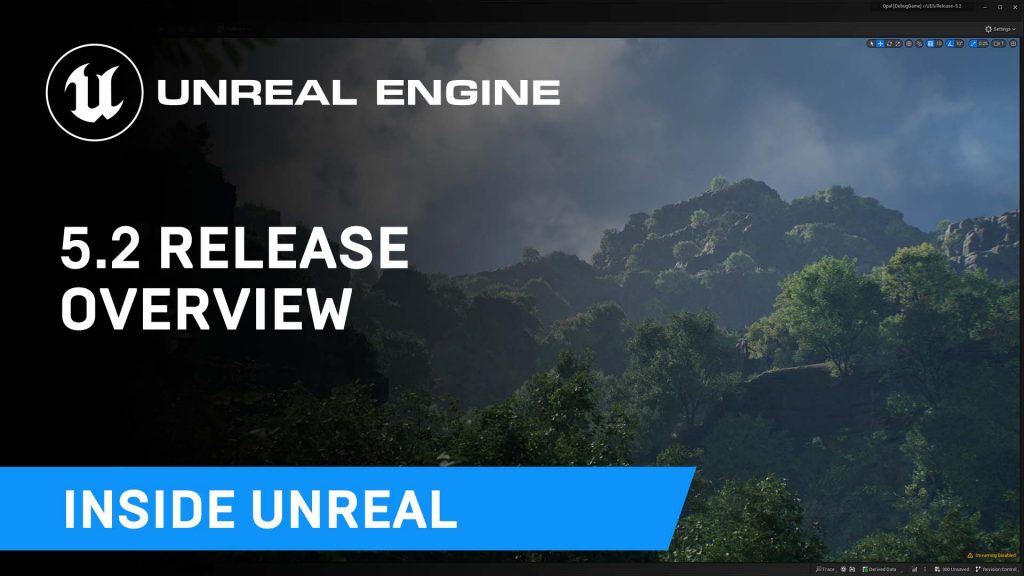The Unreal Engine has long been the go-to choice for developers and studios around the world, allowing them to develop visually stunning experiences across multiple platforms. With UE 5, the industry expects a new level of graphical fidelity and advanced features. We offer below to consider the Unreal Engine 4 comparison to UE 5.Despite the comparisons between these two versions, they are only partially true. While Unreal Engine 5 triumphs in numerous technological aspects, it lacks tutorial resources. UE 4 shines with its extensive tutorial resources, which allow users to make informed decisions and overcome potential obstacles that lie ahead. We’ll check in with the artists at Kevuru Games to highlight the essential differences. So get ready to learn about the latest features and tools that make UE last version an exciting prospect for game developers and enthusiasts alike.

New Features of Unreal Engine 5
Unreal Engine 5 introduces various groundbreaking features that push the boundaries of interactive entertainment. From cutting-edge rendering technologies to innovative audio solutions, Unreal Engine 5 empowers developers to create immersive and visually stunning experiences that captivate audiences and push the medium forward. Let’s delve into the key features of Unreal Engine 5:
1. Nanite
Nanite represents a paradigm shift in geometric detail rendering, allowing developers to import film-quality assets directly into their projects without worrying about polygon budgets or LODs (Level of Detail). This revolutionary technology leverages virtualized geometry to stream and render billions of triangles dynamically in real time, enabling stunning visual fidelity on a scale never before seen in real-time graphics.
2. Lumen
Lumen introduces real-time global illumination to Unreal Engine 5, enabling dynamic and realistic lighting without pre-baked lightmaps. This fully dynamic lighting solution simulates indirect lighting and reflections with unprecedented accuracy, enhancing virtual environments’ visual fidelity and immersion. With Lumen, developers can achieve stunning lighting effects and realistic scene illumination, bringing their worlds to life like never before.
3. Expansive Worlds
Unreal Engine 5 empowers developers to create vast, immersive worlds with enhanced scalability and performance. Through advancements in streaming and level-of-detail systems, developers can seamlessly render expansive environments with rich detail and complexity without compromising on performance or memory constraints. Whether crafting sprawling open worlds or intricate indoor environments, Unreal Engine 5 provides the tools and technology to bring ambitious world-building visions to fruition.
4. Animation Modifiers
Unreal Engine 5 introduces powerful animation tools and modifiers, enabling developers to create lifelike character animations more easily and precisely. From procedural animation techniques to advanced blending and retargeting capabilities, developers can achieve fluid and responsive character animations that enhance gameplay immersion and storytelling. With intuitive animation workflows and robust toolsets, Unreal Engine 5 empowers developers to bring characters to life in ways previously unimaginable.
5. MetaSounds
MetaSounds revolutionizes audio design in Unreal Engine 5, offering a flexible and dynamic audio system that adapts to gameplay conditions in real-time. This innovative technology allows developers to create immersive audio experiences with procedural audio generation, adaptive mixing, and spatial audio processing. From dynamic soundscapes to interactive music systems, MetaSounds empowers developers to craft immersive and responsive audio experiences that enhance gameplay immersion and storytelling.
Unreal Engine 5 Vs. Unreal Engine 4: Performance
The Unreal Engine is popular due to its exceptional performance and ability to deliver stunning images in real time. With the release of UE 5, game developers and enthusiasts are eagerly anticipating advances that will take performance to a new level.
Unreal Engine 4, released in 2014, set a new standard for real-time graphics and performance. It introduced a robust rendering pipeline, efficient memory management, and a wide range of optimization techniques. Over the years, developers have been pushing the boundaries of Unreal Engine 4’s capabilities, creating visually stunning and highly optimized games.
Unreal Engine 5 represents a significant leap in real-time graphics and pushes the boundaries of visual fidelity. With improved lighting and shadow effects, advanced particle systems, and enhanced post-processing effects, UE 5 allows developers to create incredibly realistic and lifelike worlds. In addition, enhanced rendering capabilities enable the creation of stunning images that rival pre-rendered CGI scenes in movies.
UE4 vs UE5: Automatic Optimisation
The predecessor, Unreal Engine 4, introduced several automatic optimization features that received high praise from developers. One notable feature is the Level of Detail (LOD) system, which automatically adjusts the level of detail of objects based on their distance from the camera. As a result, it can reduce the number of polygons rendered, improving performance without compromising visual quality.
Another vital UE 4 feature is the Occlusion Culling System. This system intelligently determines which objects are not visible to the camera and removes them from the rendering process. By eliminating unnecessary rendering calculations, Occlusion Culling improves performance, especially in complex scenes with numerous objects.
Unreal Engine 4 also includes automatic shader compilation, which dynamically generates and compiles shaders based on the rendering requirements of the scene. This on-the-fly compilation reduces load times and memory usage and optimizes performance without requiring manual intervention by developers.
Unreal Engine 5 builds on the automatic optimization features of its predecessor with even more advanced features. One of the most important new features is the introduction of virtualized micropolygon geometry, known as Nanite. This revolutionary technology allows developers to create highly detailed environments. Nanite dynamically streams and renders triangles with unprecedented detail, optimizing performance while maintaining visual fidelity.
Dynamic Global Illumination (Lumen) is another notable addition to Unreal Engine 5’s arsenal of automatic optimization. Lumen provides dynamic, realistic lighting in real-time by simulating bounce light and indirect reflections. This system eliminates precalculated lightmaps and allows developers to achieve high-quality lighting effects without additional manual optimization.
Unreal Engine 5 improves animation and optimization with the Chaos physics system. Chaos introduces enhanced physics simulations and destruction effects that allow developers to create realistic and dynamic interactions in their games. The system’s automatic optimization features ensure that physics calculations are efficient and performance is optimized without compromising visual quality.
Unreal Engine 4 vs 5: Enhanced API
| Unreal Engine 4 introduced a robust and comprehensive API that gives developers extensive control over the Engine’s features and functions. UE 4’s API spanned many areas, including rendering, physics, networking, audio, and user interface. It allowed developers to create custom game mechanics, implement complex AI systems, and optimize performance through low-level access to engine internals. One of the most notable features of the UE 4 API was the Blueprint system, which provided a visual scripting interface for creating game logic without writing code. This feature allowed designers and artists with little programming experience to implement gameplay features and iterate quickly. | Significant new features in the Unreal Engine 5 API is integrating Nanite virtualized geometry. Nanite allows developers to create highly detailed environments without worrying about polygon budgets or levels of detail. The API gives developers control over the streaming and rendering of virtualized geometry, providing unprecedented detail and optimization. The Lumen dynamic lighting system is another vital Unreal Engine 5 API addition. With Lumen, developers can achieve realistic lighting effects by simulating bounce lighting and indirect reflections. Unreal Engine 5 also introduces the MetaHumans API, which allows developers to use the photorealistic character creation system. The API provides comprehensive control over character customization, animation, and rendering, allowing developers to create lifelike characters easily. |
Unreal Engine 4 vs 5: Dynamic Lighting
| Unreal Engine 4 introduced a robust dynamic lighting system that allowed developers to create visually stunning scenes. The engine featured dynamic shadows, real-time reflections, and point and spotlights with adjustable properties. In addition, developers had the ability to control the intensity, color, and direction of light sources, giving them precise control over the mood and atmosphere of their games. UE 4 also supported precomputed lighting, where static lighting information could be embedded in lightmaps. This approach improved performance by reducing the real-time calculations required for lighting effects. However, this limited the flexibility and dynamism of lighting because changes to the environment or light sources required recalculation of the light maps. | The introduction of the Lumen global lighting system in Unreal Engine 5 took dynamic lighting to a new level. Lumen is a real-time lighting solution that simulates bounce lighting and indirect reflections, resulting in more realistic and immersive environments. Unlike pre-calculated lighting, Lumen dynamically calculates lighting interactions, enabling dynamic changes in the scene without requiring time-consuming light map recalculations. UE 5 also improves reflections and shadows through enhanced ray tracing capabilities. The engine uses hardware-accelerated ray tracing to achieve accurate reflections and smooth shadows, improving the overall visual quality of scenes. Developers have more control over the quality and precision of reflections and shadows, allowing for greater creative freedom. |
Unreal Engine 5 Vs. Unreal Engine 4: User Interface And User Experience
| Widely recognized as a robust and versatile game engine, Unreal Engine 4 provides a user-friendly interface and seamless user experience. The user interface is clean and intuitive, allowing developers to navigate the various tools, blueprints, and assets efficiently. The Blueprints visual scripting system allows designers without programming experience to create complex interactions and game mechanics effortlessly. User experience focuses on usability and accessibility, allowing developers to focus more on actual game design and less on technical complexity. | Unreal Engine 5 takes the UI and UX to a new level, leveraging advances in technology and design. A new coat of paint gives the user interface a sleek and modern design that provides developers with a more engaging work environment. In addition, the menus and toolbars have been restructured to improve organization and quick access to key features. Unreal Engine 5 also introduces a redesigned content browser that makes managing and navigating assets easier. |
Unreal Engine 5 Vs. Unreal Engine 4: Modeling Tools
| UE 4 has been a game-changer for the industry, providing developers with robust modeling tools. Its Blueprint visual scripting system allows artists and designers to create complex game logic without writing a single line of code. UE4’s Static Mesh Editor also enables users to design and manipulate 3D models efficiently. The engine also offers material and texture editors, allowing for the creation of visually stunning game assets. | UE 5 offers one of the most notable enhancements is the introduction of Nanite, a virtualized micropolygon technology that enables artists to create highly detailed models without worrying about performance limitations. With Nanite, developers can incorporate millions or even billions of polygons into their scenes, resulting in unprecedented realism. |
What Do Users Say About Unreal Engine 4 and 5?
Users worldwide assure us that Unreal Engine 5 has revolutionized the game development landscape. User feedback has been overwhelmingly positive about this state-of-the-art game engine’s power, flexibility, and breathtaking capabilities.
Unreal Engine 4, the foundation on which the industry stands, has been hailed as a game-changer in terms of its versatility and ease of use. Users marvel at the engine’s robustness, allowing developers to create stunningly realistic graphics, mesmerizing worlds, and immersive gaming experiences. From indie studios to the titans of AAA, Unreal Engine 4 has enabled developers of all sizes to realize their wildest visions with unprecedented efficiency. But the progress continues.
Epic Games, the visionary minds behind the technological marvel that is Unreal Engine 5, have continued to push the boundaries and elevate game development possibilities to extraordinary heights. The introduction of Nanite and Lumen has also given developers an arsenal of tools to create experiences that blur the line between reality and the virtual world.
User testimonials speak volumes about the impact of Unreal Engine 4 and 5, with the engines’ developers emphasizing how user-friendly and artist-friendly they are, allowing users to unleash their creative potential without encountering technical obstacles. In addition, the extensive support, documentation, and vibrant community have created an environment where knowledge-sharing and innovation thrive and collectively drive the industry forward.
Beyond the gaming industry, the Unreal Engine’s influence has extended to several industries, including architectural visualization, film production, virtual reality, and augmented reality.
Can We Move Projects Developed With Unreal Engine 4 to UE5?
Epic Games, the creators of UE, have ensured that projects developed with Unreal Engine 4 are compatible with Unreal Engine 5. This forward compatibility means you can migrate your existing projects without losing progress or assets. The transition is designed to be seamless, allowing you to leverage UE5 features while preserving your work from UE4. Migrating your project from UE4 to UE5 involves a few essential steps:
1. It is recommended to back up your UE4 project before proceeding with the migration. This precautionary measure ensures that you have a fallback option in case any unexpected issues arise during the process.
2. You must open your UE4 project in Unreal Engine 5. The UE5 editor provides a migration tool that automates updating your project to the latest version. This tool scans your project files, identifies the necessary changes, and updates them accordingly. It’s important to carefully review and test your project after the migration to ensure everything functions as intended.
3. After migrating your project to UE5, thorough testing and iteration are essential. UE5 provides enhanced performance and optimization, allowing you to push the boundaries of your project’s visual fidelity and complexity. Test different scenarios, evaluate performance, and iterate on your project to ensure that it takes full advantage of UE5’s capabilities.
Conclusion: UE4 vs UE5 The Major Differences
As we conclude our exploration of Unreal Engine 4 (UE4) and Unreal Engine 5 (UE5), it becomes evident that both engines have made significant contributions to the world of game development. However, key differences set UE5 apart and make it a highly anticipated upgrade for game developers worldwide.
1. Unreal Engine 5 introduces Nanite, a revolutionary technology that redefines how game models are created and optimized. Nanite’s virtualized micropolygon system allows for an unprecedented number of polygons in a scene, resulting in highly detailed and lifelike models. This breakthrough eliminates the need for a manual level of detail (LOD) creation and streamlines the modeling process, saving developers valuable time and resources.
2. Lumen, a real-time global illumination system that brings stunning lighting effects to game worlds. Lumen accurately simulates the behavior of light, allowing for dynamic and realistic lighting and shadows.
3. MetaHuman Creator, an innovative tool that simplifies the process of creating realistic and believable characters. With this tool, developers can easily generate high-fidelity human characters, customizing attributes such as facial features, body types, and clothing.
4. UE5 performance and optimization, offering improved memory management and streamlined rendering techniques. The engine’s Virtual Shadow Maps (VSM) technique enables efficient and realistic shadow rendering, while its overall optimization allows for larger and more detailed game worlds without sacrificing performance.
5. One of the most significant advantages of UE 5 is its forward compatibility with projects developed in UE 4. It means that developers can seamlessly migrate their existing projects to UE5, preserving their progress and assets while taking advantage of the new features and enhancements.










